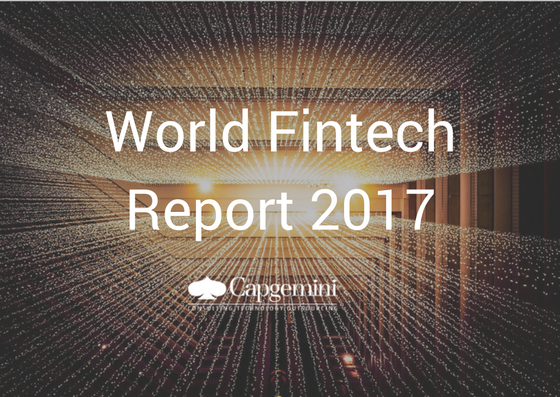
World Fintech Report 2017 – Capgemini
The following summarises the World Fintech Report 2017, published by Capgemini in Q2, 2017.
1. Rise of the Fintech Movement – The World Fintech Report
According to the World Fintech Report, the rise of the Fintech industry can be attributed to the following reasons:
- Increased customer expectations
- Lower barriers to entry
- Increased access to VC funding
- Accelerated technological advancements
1a. Increased customer expectations
The improvements in technology have provided consumers with superior personalised and digital interactions every day. BigTechs like Google, Amazon, Facebook and Apple have raised the bar of customer expectations. Traditional firms however, as the World Fintech Report described, have been slow in reacting to increasing customer expectations.
1b. Lower barriers to entry
Traditional financial firms are facing increasing regulations, inflexible legacy systems and siloed channels, which adds to operational costs. Fintech firms, however, are nimble as these startups are able to capitalise on next-generation technology without being restricted by existing systems and cultures. Regulators simplify the regulatory processes in order to boost innovations in the financial industry. In addition, regulators involve them in the early stages of drafting regulations. The lower cost of readily available cloud services also save them from investment costs and allow them to spring up readily.
1c. Increased access to VC funding
VC funding in the Fintech industry has increased exponentially over the past few years. This provided a potent spark to the financial services industry as a whole, spurring traditional firms to be active in product development as Fintech innovation rises. The intense focus of VCs on Fintechs, however, may be giving the false impression that many have scalable or viable business models, which may or may not be able to compete in the medium to long term.
1d. Accelerated technology advancements
Fintech firms are having an impact and redefining customer engagements by moving quickly to deliver customer-focused solutions at low cost. Traditional firms are burdened by their legacy systems and culture, restricting them to engage customers effectively. In general, younger, tech-savvy and affluent customers are much more likely to rule out basic financial services with Fintech offerings. Nonetheless, most Fintechs are operating within their niche, and it would be rare for them to look at taking over the entire banking relationships.
Despite the rise of Fintech movement, traditional firms still hold various competitive advantages. They are perceived to be better in fraud protection, quality of service and transparency. As for delivering basic transactions such as opening accounts and providing access to information, Gen Y (aged 18 to 34) perceived Fintech firms to be on par with traditional firms.
A summary of customer value perception for traditional vs. non-traditional firms can be seen below:
2. Fintechs and Traditional Firms Must Improve on Delivering Positive Moments of Truth to Customers
Based on the World Fintech Report, firms should improve day-to-day interactions as these interactions have great impact on how customers feel towards the firm. There are four key findings:
- Customer experience levels low, but mobile likely poised to follow path of computer adoption
- Gen Y, tech-savvy embrace mobile
- Moments-of-truth interactions fall short
- Gen Y and tech-savvy customers key to driving profitable customer behaviour
2a. Customer experience levels low, but mobile likely poised to follow path of computer adoption
In a survey of more than 8,000 customers in 15 countries around the world, the overall positive experience level of financial services is only 31.1%, which is considered low. Against a backdrop of regulatory constraints, legacy system and branch networks, it reflects the industry’s ongoing effort to add digital services. An estimated two billion people will have their first banking experience on a smart phone within ten years.
Despite the bulk of digital transactions occurring over the mobile phone, the survey also found that personal computer remains as the most important and preferred banking channel. This is partly because mobile banking functionality often falls short. Yet, mobile emerged as the second-most important channel for Gen Y (47.6%) and tech-savvy (56.5%), and is benefiting from the steady release of innovative products by non-traditional providers.
2b. Gen Y, tech-savvy embrace mobile
With the prospect of the above statistics from the World Fintech report, Fintech firms are greatly focused on convenience and personalisation of mobile-based services, such as using “GPS to offer users real-time overdrafts if their funds are running low”. Traditional lending firms are not far behind as they direct innovations toward new services through mobile channels as well. They also take advantage of their rich resources and broad experience as they pursue optimal strategies for maximizing opportunities in digital delivery.
2c. Moments-of-truth interactions fall short
One way of maximizing opportunities in digital delivery is to provide pleasant experience in daily interactions.
The World Fintech report highlights its research results on customer’s view of the below key interactions per below.
2d. Gen Y and tech-savvy customers key to driving profitable customer behavior
One important tool in delivering better customer experiences is innovation. Targeting key customer segments of the future, Gen Y and tech-savvy customers, customers show a willingness to embrace innovation in financial service firms such as fingerprint and face recognition. This is in contrast to business’s emphasis of fee transparency. It is therefore recommended to understand the needs and identify key moments-of-truth of the Gen Y and tech-savvy, and proceed with a focused plan to introduce next-generation offerings.
3. In Face of Fintechs, Traditional Firms Struggle to Apply Innovation
Eventual impact of Fintechs on traditional firms remains unclear
Most executives agree that Fintechs are impacting financial services businesses, but there is little consensus on how far it will go. Here are various thoughts and beliefs about Fintechs regarding this aspect from the World Fintech report:
- Fintechs do not have the ability to scale or maintain a value proposition that cannot be easily replicated by traditional firms
- Fintechs lack the capital of large financial institutions, face uncertainty in venture capital funding and lack experience in dealing with regulators
- Traditional firms have some inherent advantage such as having a physical presence that could be a positive advantage
- Fintechs are niche players with very specific capabilities, they might end up collaborating with traditional firms, perhaps taking on second-tier roles or cherry-picking the best parts of a traditional firm’s business
- Nonetheless, they are disrupting existing markets with their expertise, leading to entirely new ways of dong business
Executives believe Fintechs excel in delivering better customer experience
Executives and customers’ views on importance of factors while working with their firms can be summarized below:
Traditional firms increasingly view Fintechs as partners
When considering whether Fintechs are potential partners or threats, the statistics below provide an understanding from the point of view of traditional firms’ executives. Majority see partnership opportunities with Fintechs, allowing traditional firms to leverage on the innovative new technologies that Fintechs have to offer.
Progress on innovation slow for traditional firms, despite high confidence
With regards to the progress on their innovation for traditional firms, the statistics and the graph from the World Fintech report below provide an understanding from the point of view of traditional firms’ executives.
- 44% of executives are very confident they have the right strategy in place to address Fintechs
- 43% of the executives are moderately confident they have the right strategy in place to address Fintechs
- 13% of the executives do not trust their strategy, a fact that will make it much harder for them to achieve success
Results in innovation not yet measuring up to the effort
As the pace of Fintech disruption picks up and institutions put in effort to advance, they may find themselves falling further behind. This is supported by the research: it illustrated the fact that areas in which firms are most active in (partnering with Fintechs and developing in-house capabilities) are not reaching a proportional size of effectiveness.
Traditional firms can compete by putting executives with strong technology backgrounds into leadership positions. These important individuals are necessary to deploy advanced technology vital to innovation. 89.5% of executives agreed that Big Data and Analytics will have an impact on their business and operating models by improving on customer experience through personalised services. Others include blockchain, Internet of Things (IoT) and cloud computing which can optimize resources, support fast and secure transactions and therefore lower cost of product development while improving response speed to customers.
Risk-adverse cultures smash innovation
Traditional firms understand that innovation has to be a priority to keep up with Fintechs. However, on the contrary, 40.3% of executives say their culture is not conducive to innovation, while 37.3% say that budget constraint thwarted innovation. 29.9% focused on business-as-usual (BAU) efforts and 28.4% pointed at legacy systems which are inflexible. Innovation is difficult for institutions to accept philosophically as it represents a shift in how the industry approaches technological advancements, from making processes cheaper than making it better. In addition, most financial institutions operate on strict return-on-investment (ROI) princicples and do not consider technologies without clear payback.
4. Inculcating innovation requires methodical approach
Based on the World Fintech report done by Capgemini on the Fintech industry, they proposed the below approach in hoping to inculcate innovation.
Spreading innovation step by step
Traditional firms have the resources and capacity to innovate greatly, beating Fintechs at their own game. On the other hand, Fintechs may possibly continue to grow, perhaps even acquiring traditional firms. The World Fintech report states that overcoming the financial industry’s resistance to innovation is not easy but achievable with 4 steps.
Devise
After completing the discovery phase, institutions need to devise a master plan for spreading innovation, considering its internal strengths and weaknesses. The World Fintech report states that the primary step is to identify a talented leader who has both vision and experience. Having a strong technology background to execute the plan is crucial as well. All the teams involved must have a common vision and have awareness of the bigger picture. Formal processes for iterative development and rigorous testing are required to facilitate elimination of unwanted surprises and ensure customer acceptance.
Deploy
The World Fintech report suggests that the key to successful deployment of innovation with speed and scale is to acquire support from all levels of management and create a culture of innovation effectively. They must be able to comprehend the benefits that can accrue to them. Employees have to understand the reasons behind the possibility of changes to their job descriptions. Once the communications tasks are completed, firms can either roll out their solution in phases or introduce it to all customers at once, only if they are confident of the customer’s support and scalability of the solution.
Sustain
After deploying the solution, firms need to make a concerted effort to maintain pace and energy of the start-up culture. This includes sharpening the innovation skills in an embracing-failure environment, and formulating incentives to recognize and reward good ideas. The World Fintech report suggests that firms must regularly assess customer responses and expectations for further innovation and development.
5. Culture Change Begins at the Top
Having a methodology for building and sustain innovation is insufficient. The most important success factor is gaining the support of the top management, as shown below from the World Fintech report:
According to World Fintech report, Fintechs are vulnerable to business continuity issues, security breaches, scaling difficulties and compliance risks. As such, traditional collaboration with Fintechs require picking the right partners, considering the specific expertise they can bring along and others as shown below:
6. Disruptive forces in the Fintech Landscape loom for traditional firms
Based on the World Fintech report, traditional firms could be reduced to providing-end core processing services to Fintechs, which would dominate the front-end customer relationship.
Aside from Fintech disrupting the financial services industry, BigTech firms, such as social media, e-commerce and telecommunications companies, represent a potentially even bigger disruptive force in financial services. These firms, according to the World Fintech report, possess super data processing capabilities and none of the challenges Fintechs possess in winning over customer trust. They can also provide front-end customer services. As a banking executive agreed, “They are only a charter application away from game over”.
Another disruptive force is the blockchain technology which eliminates the need for intermediaries for transactions. Banking on identity, an innovative concept, eliminates the need for currencies by allowing users to define what is valuable to them, create it, and hold it in their phones. This way, based on the World Fintech report, customers are custodians of their own data, eliminating the issue of having to design the perfect data model.
Related Articles
The World Retail Banking Report 2016
Connecting Global Fintech: Hub Review 2016
References
Capgemini, LinkedIn, Efma. (2017). World FinTech Report 2017, link
Related Articles

Singapore Businesses Remain Positive Outlook for 2024

Unveiling the Atradius Payment Barometer 2023: Downbeat Exports Outlook Poses Challenge for B2B Trading on Credit







